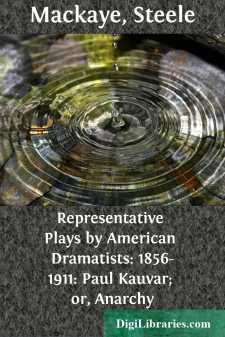Categories
- Antiques & Collectibles 13
- Architecture 36
- Art 48
- Bibles 22
- Biography & Autobiography 813
- Body, Mind & Spirit 142
- Business & Economics 28
- Children's Books 17
- Children's Fiction 14
- Computers 4
- Cooking 94
- Crafts & Hobbies 4
- Drama 346
- Education 46
- Family & Relationships 57
- Fiction 11829
- Games 19
- Gardening 17
- Health & Fitness 34
- History 1377
- House & Home 1
- Humor 147
- Juvenile Fiction 1873
- Juvenile Nonfiction 202
- Language Arts & Disciplines 88
- Law 16
- Literary Collections 686
- Literary Criticism 179
- Mathematics 13
- Medical 41
- Music 40
- Nature 179
- Non-Classifiable 1768
- Performing Arts 7
- Periodicals 1453
- Philosophy 64
- Photography 2
- Poetry 896
- Political Science 203
- Psychology 42
- Reference 154
- Religion 513
- Science 126
- Self-Help 84
- Social Science 81
- Sports & Recreation 34
- Study Aids 3
- Technology & Engineering 59
- Transportation 23
- Travel 463
- True Crime 29
Representative Plays by American Dramatists: 1856-1911: Paul Kauvar; or, Anarchy
by: Steele Mackaye
Description:
Excerpt
STEELE MACKAYE
(1844-1894)
When one realizes the sociological purpose behind Steele Mackaye's "Paul Kauvar; or, Anarchy," it is interesting to note how inefficient the old form of drama was to carry anything more than the formal romantic fervour. Compared with John Galsworthy's treatment in "Strife" and "Justice," it makes one glad that realism came and washed away all the obscuring claptrap of that period. Daly, Boucicault, and their generation were held firmly in its grip; they could not get away from it, and they were justified in their loyalty to it by the insistent claim "The Two Orphans" and "The Lady of Lyons" had upon the public. All the more credit, therefore, that Bronson Howard, David Belasco, and James A. Herne escaped it; had the latter completely freed himself of melodrama, his plays would be better known to-day, better capable of revival, because of the true greatness of their simple realistic patches.
But where Mackaye vitalized the old style was in the vigour of his treatment. He loved the large scene, the mob movement; and he worked with a big brush. As Nym Crinkle, the popular New York World dramatic critic of the day, wrote: "Whatever else he may be, [he] is not a 'lisping hawthorne bud'! He doesn't embroider such napkins as the 'Abbé Constantin', and he can't arrange such waxworks as 'Elaine'. He can't stereoscope an emotion, but he can incarnate it if you give him people enough."
Mackaye's mind was large, resourceful, daring—both in the opinions it upheld, and the practical theatrical innovations it introduced into the theatre, like the double stage for the little Madison Square playhouse, in New York, which was the precursor of such modern paraphernalia as came later with the foreign revolving stages. He always stood on the threshold of modernism, advocating those principles which were to fructify in the decades to follow him. Such pioneer spirit was evident in his ardent advocacy of Delsarte methods of acting; his own work as an actor was coloured and influenced by the master whose pupil he became in the early years of his career. When one recalls the methods of Wallack, and his shy approach toward anything which was "natural," it seems very advanced to hear Mackaye echoing the Delsarte philosophy. This advocacy was nowhere better demonstrated than when, at a breakfast given him at the New York Lotos Club, he talked on the rationale of art for two hours, and held spell-bound the attention of Longfellow, Bryant, Louis Agassiz, James J. Fields, E.P. Whipple, Edwin Booth and others. He once said:
A man to be a true actor must not only possess the power to portray vividly the emotions which in any given situation would be natural to himself, but he must study the character of the man whom he impersonates, and then act as that man would act in a like situation.
Mackaye's devotion to Delsarte was manifest in the many practical ways he aided his teacher; he was rewarded by being left most of his master's manuscripts. This passionate interest in the technique of acting not only enriched his own work, but, in 1872, prompted him to open a Delsarte house (the St....


